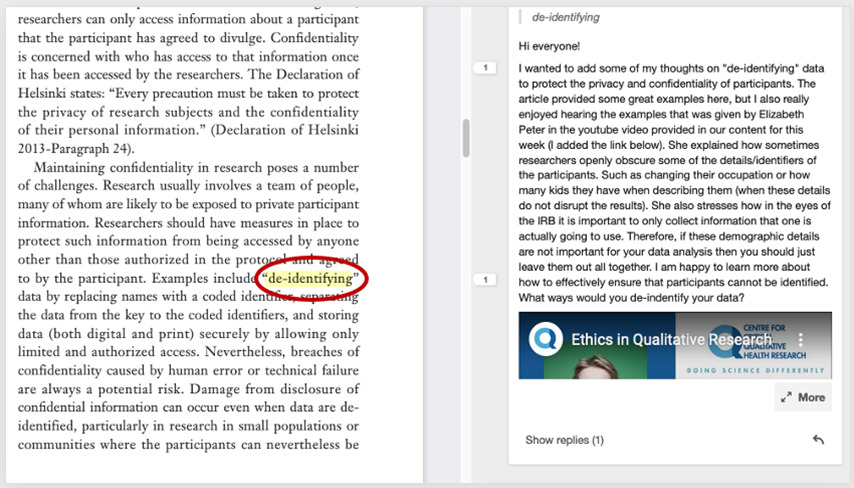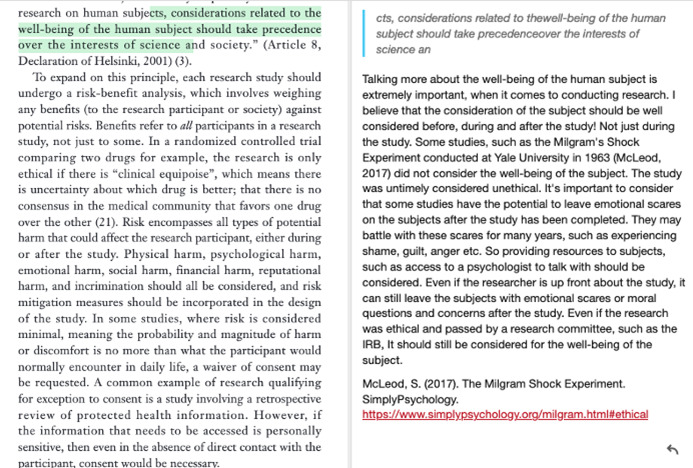
Engaging Students in Discussion through Hypothes.is
Social annotation tools allow instructors to post a reading to a website and then have students tag it with comments. These provide many benefits
Social annotation tools allow instructors to post a reading to a website and then have students tag it with comments. These provide many benefits for students and instructors. One, they can demonstrate to the instructor that students are reading an article, especially if the instructor requires each student to make one or more postings. Two, they can demonstrate where students struggle in understanding articles. Three, students can use them to better comprehend articles by asking questions and getting responses from their peers. Four, they better connect discussion to an article than a separate learning management system discussion forum. This can be particularly helpful in classes that require students to do close readings of texts, such as in a Shakespeare class when analyzing a particular play or in a graduate class when dissecting an academic article.
Hypothes.is an excellent option for implementing social annotation, as I did in my master’s level public health qualitative research course. This free, open-source software allows students to annotate websites, blogs, online journals, PDFs that have been imported to the site, and news articles. Moreover, Hypothes.is allows students and faculty to tag annotations for themes that can lead to further discussion.
Students often do not know what they should be getting out of an article, and as a result they read for the wrong things. An instructor can address this problem by posting comments to an article that highlight important themes before students read it. This helps scaffold student reading. I went one step further by creating a screencast overview of each class article for the students, as comments can include videos. The instructor can then asked students to make a variety of different types of postings. They can ask questions about parts of the article that they do not understand and get answers from other students, or post answers to other students’ comments. These questions can initiate branching discussions. They can also object to things the author says. I have students amplify points in an article by adding thoughts and resources related to it as web links or videos. Figures 1 and 2 provide examples of discussion with a video or a link embedded into Hypothes.is as an ancillary resource to enhance engagement in learning.


I would suggest directing students to the Hypothes.is resource page that provides both technical guidance on how to use the system and good information on how to ensure that the annotation adds to the information in the resource. I would also suggest organizing what you would like students to read and reflect upon in a single location, such as Google Drive, to make it easier to find and post articles. Additionally, post a mini screencast to help students focus on what they should take away from the article or what you hope they’ll learn, as well as notes throughout to highlight important points or raise questions for reflection. I would suggest providing students with a minimum and maximum number and length of comments to help teach them to be concise in their reflections. Finally, you might require students to provide an ancillary resource that develops an idea in the main resource to help other students who are doing further research on the topic. This requirement will also help students learn to find credible information.
Hypothes.is is not the only social annotation tool, and instructors might compare its functionality with other tools to determine the best fit with their needs. Perusall can be helpful in large courses because it allows for auto-grading students based on a number of annotations and replies. It also can provide access to a number of publisher texts through a searchable database. While Perusall requires a separate login for students, instructors can integrate it into Canvas and other learning management systems. NowComment broadens the range of media students can annotate to include texts, images, and videos.
Julia VanderMolen, PhD, is an associate professor of public health in the School of Interdisciplinary Health at Grand Valley State University.